
The style may be ‘retro’, but this powerful integrated amp from a Far East legend is no exercise in nostalgia: it lacks fashionable digital inputs, but has serious sonic appeal Review: Andrew Everard Lab: Paul Miller
OK, so it may help explain the whole ‘vinyl revival’ thing, from portable record players with greater tracking weight than a Caterpillar bulldozer to supermarket own-brand LPs, but looking to the past will only get you so far. Forget all that longer summers, colder winters and ‘jumpers for goalposts’ stuff: even nostalgia’s not what it used to be. Products must stand on their own merits in today’s competitive market.
RESOLUTELY ANALOGUE
You see, there’s not exactly a shortage of big-money integrated amplifiers out there, and launching the £8500 L-509X into that arena sees Luxman facing rivalry not only from other manufacturers, but also from within. After all, the company has a handful of integrateds on its books, all of which look somewhat similar at first glance, distinguished only by the colour of their meter illumination and price. The designation echoes the original L-509fSE, which first saw the light of day back in 2002 as an attempt to combine the virtues of preamp and power amps in a single chassis, while slightly confusingly there’s already the similarly-numbered L-590AXII [HFN Apr ’16].
Now we have the L-509X, and while the basis is the same, this is a somewhat different animal, with a claimed output of 120W/8ohm, rising to 240W/4ohm – not that the L-590AXII proved exactly starved of power when PM lab-tested that one, delivering 95W/8ohm and 165W/4ohm. I have to confess to being something of an adherent to the maxim that a bit of extra grunt never goes amiss when it comes to the ease with which music is delivered, and so it proves with this new Luxman.
A bit of extra grunt may also be what you emit when called upon to unbox and set up the L-509X for it weighs a not insubstantial 29.3kg. At least the effort gives you a reassuring sense of where all your money’s gone, an impression that’s reinforced when you have the amplifier in place, connected up and switched on.

The star turn, as on all current Luxman amps, is the presence of the two illuminated meters, placed exactly front and centre, but the symmetrical layout of the substantial fascia is also highly pleasing, as is the attention clearly paid to the feel and weighting of the controls. There may not be the knowingly retro flip-switches of the wood-sleeved ‘Classic Series’ Luxman products, but even before you start using it in anger the L-509X has a sense of substance and total quality – luxe indeed. The design here is very much classic‘ preamp and power amps in one box’, with the two sections able to be split if required. And at heart this is a very simple amplifier, with none of that built-in DAC nonsense, let alone a sniff of a Wi-Fi antenna or Ethernet port – it’s resolutely analogue, with no more than four line-ins on RCA sockets plus two sets of balanced inputs, plus a switchable MM/MC phono stage.
‘The Mael brothers’ sound is an exercise in studied chaos’
HARD AS BRASS
Record out and monitor sockets are provided, along with pre-out/power amp in – you could use the last of these to integrate the L-509X with an AV receiver or processor – and there are two sets of switched speaker outputs and a fascia headphone socket. The controls, though there seem to be a lot of them on the front panel (somewhat at odds with the ‘input selector, volume control and that’s it’ trend), are similarly simple. The input selector is one of the two beautifully precise knobs either side of those meters, while the identical-sized adjustments arranged below allow MM/MC cartridge selection, record out, speaker switching and tone/balance controls, bypassable using the ‘Line Straight’ button. Oh, and there’s a remote handset provided [see p39], also able to ‘drive’ a Luxman disc player – and turn off the L-509X’s meter illumination too.
The volume control bears the legend ‘LECUA’, which looks like one of those meaningless Japanese terms, right up there with Acura, Regia and Canter (the last of these an unfathomable designation for a range of trucks). In fact, LECUA is the Luxman Electric Controlled Ultimate Attenuator, here in its latest LECUA 1000 version, which controls both volume and balance with a system directly connecting the substrate of the attenuator and amp circuits to reduce noise, and offering 88 steps of volume adjustment. Other claims for this design include greater resistance to the effects of vibration, enhanced accuracy across the volume range, and long-term durability.
This system is inherited from the company’s C-900u flagship preamp [HFN Sep ’15], as is the buffering circuit in the preamp section, designed for optimal drive of the power amp stages. The output stage itself uses a push-pull configuration equivalent to that in the company’s M-700u power amp, and outputs through copper alloy terminals said to have the conductivity of copper plus the hardness of brass. The switched connection to the output stages is via high capacity/low resistance parallel relays and thick copper wiring to maintain the claimed high damping factor. The whole plot is sustained via no fewer than six independently rectified/regulated PSUs fed from separate transformer windings – even the protection circuitry has its own supply. The substantial 600VA transformer, Luxman says, is a ‘high inertia’ design ‘that does not shake even under load fluctuations’. Well, that’s all good, then. The vibration-resistance goes beyond that hefty, thick panel work in evidence in the ventilation grilles in the top panel, for rather than use fancy damping feet in exotic materials, the L-509X simply sits on massive cast-iron supports. Sometimes a little brute force is the best way!
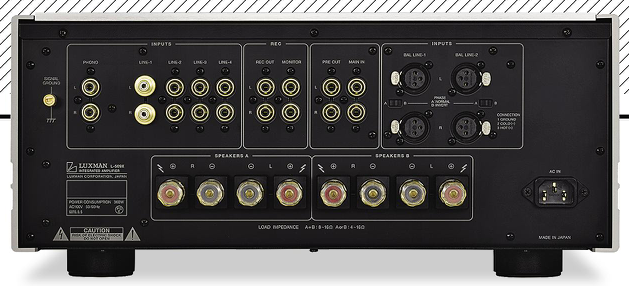
SWEET AND EASY
Not that there’s anything brutal about the way this amplifier plays music. Give it a while to settle down from cold – as PM noted during his lab testing [p39], when set to play at a given output level the meters kick up a bit after a while of running, at which point the L-509X can be assumed to be cooking pretty well, and good to go. And the immediate impression is that, while there’s no mistaking this for an amplifier with anything less than ‘more than sufficient’ power under the hood, it sounds sweet, refined and entirely at ease, whatever the music you choose to play through it, and whichever source component you opt to use.
It’s not quite a ‘take no prisoners’ ultra-revealing amp of the brash and bright school, though the amount of information it delivers is frequently breathtaking, and it never leaves the listener with the sense that something’s missing. So however big and rich the bass may be it’s also entirely controlled, tight and rhythmic as well as having wonderful character. From the growl of orchestral double-basses in a spot of Wagner from the excellent overview of the composer’s work by Iván Fischer and his Budapest Festival Orchestra [Channel Classics CCS SA 32713; DSD64], all the way through to the snap and punch of Kyle Eastwood’s instruments on his recent In Transit set [Jazz Village JV570146; 44.1kHz/24-bit download], this is an amplifier fully able to convey instrumental textures and techniques.
What’s more, while the brass duo leading several of the Eastwood tracks can sound overly aggressive via some amps, the L-509X conveys them in fluid, attractive fashion without blunting either their breathiness or the metallic edge to the sound. In other words, it does excitement to spellbinding effect – just without the irritation. Even with a really dense mix, such as some of those on Squeeze’s The Knowledge [Love Records LVRCD004], this amplifier manages the impressive task of delivering the big, majestic wash of sound while still allowing the usual masterful lyrics and the individual instruments due clarity.
NO EXCUSES NEEDED
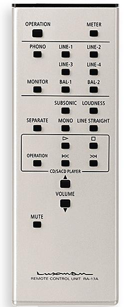 The L-509X rewards both ‘lean back’ and ‘lean forward’ listening, not least because it always seems entirely in control of the speakers, with no sense of speed-impeding smear or overhang. Notes start sharply and decay realistically, giving a sound that’s both immediate and delivered with real presence. It’s a sound that even the wilful mayhem of the latest Sparks set, Hippopotamus [BMG 538279612], can’t catch out. Yes, the sound the Mael brothers deliver is an exercise in studied chaos, but even those falsetto’ish vocals are clearly audible in a track like ‘So Tell Me Mrs Lincoln Aside From That How Was The Play?’, which is every bit as bonkers as the title suggests. It may not be quite what the Luxman engineers had in mind when they designed the L-509X but the fact it works so well shows that their amplifier has wide-ranging capabilities beyond the breathy jazz of so many hi-fi demonstrations.
The L-509X rewards both ‘lean back’ and ‘lean forward’ listening, not least because it always seems entirely in control of the speakers, with no sense of speed-impeding smear or overhang. Notes start sharply and decay realistically, giving a sound that’s both immediate and delivered with real presence. It’s a sound that even the wilful mayhem of the latest Sparks set, Hippopotamus [BMG 538279612], can’t catch out. Yes, the sound the Mael brothers deliver is an exercise in studied chaos, but even those falsetto’ish vocals are clearly audible in a track like ‘So Tell Me Mrs Lincoln Aside From That How Was The Play?’, which is every bit as bonkers as the title suggests. It may not be quite what the Luxman engineers had in mind when they designed the L-509X but the fact it works so well shows that their amplifier has wide-ranging capabilities beyond the breathy jazz of so many hi-fi demonstrations.
That said, when you do treat it to a demonstration-quality recording, such as Classical Opera’s lovely set of Mozart’s Il Sogno diScipione [Signum Classics SIGCD499, 96kHz/24-bit], the LX-509X’s warmth and vitality come together to create a truly exciting presentation, the soundstage broad, deep and detailed, the presence and ambience almost uncanny, and the dynamics so wide open that one could easily forget all the machinery involved between performance and the listening experience. This amplifier is no mere exercise in rose-tinted nostalgia, and needs none of those ‘ah, but in those days…’ excuses to be made. It’s simply special.
HI-FI NEWS VERTICT
Big, rich, sweet and totally controlled: sounds like something of a soft listen, doesn’t it? Yet the truth is that the L-509X is all of the above in a good way, and none of those in a bad: it simply conveys the music in a manner that always seems exactly as it should. Don’t look at the styling and expect all those clichés of amplifiers of yore – this is a bang up to date design, in both engineering and sound.
LAB REPORT
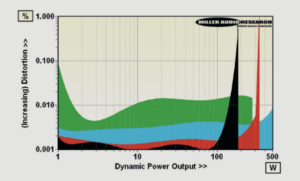
Power meters are always fun to watch and, here, are ‘calibrated’ in dB relative to full output. In practice the red ‘0dB’ point is pretty close to Luxman’s rated 120W/8ohm but, perhaps more importantly, a 10W/8ohm output is indicated at –15dB when the amplifier is cold and –10dB when it is warm… So treat the meters as decoration rather than a precise measure of level! Precision is the watchword in our lab reports, of course, and here it was soon clear that while the L-509X might look almost identical to the L-590AXII [HFN Apr ’16] its technical performance suggests a merger of the brand’s C-700u/M-700u pre/power [HFN Sep ’15]. Indeed, where the former racked-up a full 2x145W and 2x250W into 8/4ohm, increasing to 165W, 315W and 551W into 8, 4 and 2ohm loads under dynamic conditions, the new L-509X delivers a very similar 2x155W/8ohm and 2x255W/4ohm with a dynamic 183W, 342W and 507W into 8, 4 and 2ohm. With both the M-700u and L-509X, protection limits output to ~300W/1ohm or 16.7A [see Graph 1, below].
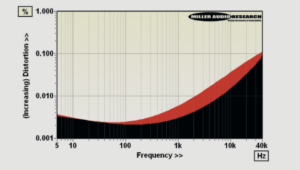
In similar fashion, the integrated L-509X has –1dB response limits of 3Hz-42kHz (–4.6dB/100kHz) while its 0.02ohm output impedance, rising to 0.05ohm/20kHz and 0.43ohm/100kHz still encourages a slightly earlier roll-off into tougher loads. Distortion is also very low at <0.002% from 20Hz-1kHz before rising gently to 0.03%/20kHz (all at 10W/8ohm). Where the L-509X scores, however, is in maintaining this distortion trend with increasing output, so THD is 0.0025% at 1kHz/1W, 0.0026% at 100W and 0.0034% at the rated 120W. Meanwhile, bearing in mind its high +43.4dB overall gain (balanced input), the A-wtd S/N ratio is a solid 86dB (re. 0dBW) while separation is >80dB midband. PM
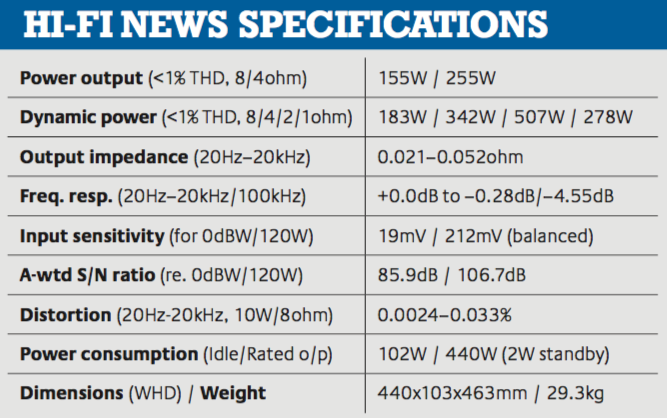
From HiFi News

